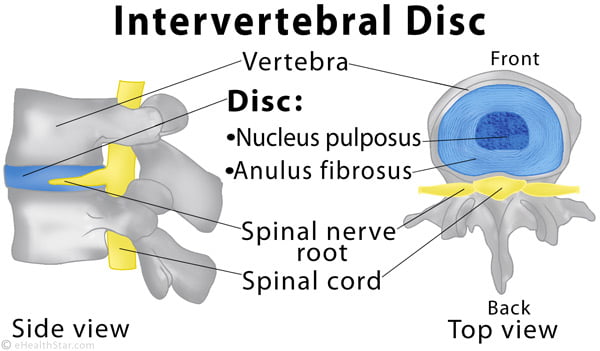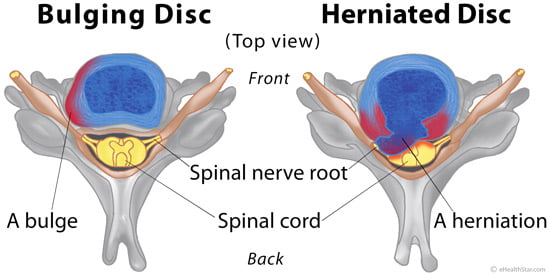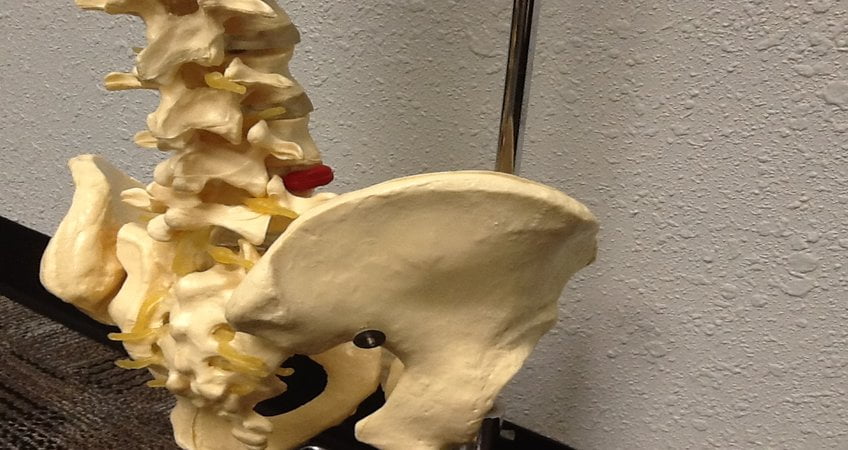Bulging Disc and Herniated Disc
What is an intervertebral disc?
Both a bulging disc and an herniated disc are conditions that affect the intervertebral disc. The intervetebral disc is a spongy, oval-shaped “shock absorber” that is located between vertebrae. Discs cushion the vertebrae, contribute to flexibility and help to protect the spinal cord. Discs are composed of two main structures the annulus fibrosus and a nucleus pulposus.
- The annulus fibrosus is a strong radial tire–like structure which encloses the nucleus pulposus.
- The nucleus pulposus contains a hydrated gel–like substance and is made up of mostly water. Think of the nucleus pulposus as the jelly inside of a doughnut and the annulous fibrosus as the dough surrounding the jelly.

Contents of an intervertebral disc
What’s the difference between a bulging disc and an herniated disc?
The terms bulging disc and herniated disc often times get thrown around as synonymous, however there is differences between the two conditions.
- A bulging disc is “contained.” This means no tear or rupture is present within the outer layer of the disc. A small “bubble” protrudes into the spinal canal. No portion of the nucleus pulposus has leaked out of the disc.
- A herniated disc is “non-contained,” which means a tear or rupture is present. A portion of the gel-like nucleus pulposus has leaked into the spinal canal. A herniated disc might have begun as a bulging disc, but created so much pressure on the outer wall of the disc that a rupture occurred.
In addition to producing similar symptoms, herniated discs and bulging discs have similar causes. Poor posture, a spinal injury, repetitive spinal strain or the normal wear and tear of age can lead to either condition. Depending upon the location in the spinal column they may cause radicular symptoms into the shoulder/arm/hand or down into the hip/knee/foot. Also, they may present with no symptoms at all.

Difference between a bulging disc and a herniated disc
Treatments for a bulging or herniated disc
At Behm Muscle & Joint Clinic we offer a triad of care in treating your herniated or bulging disc. We provide Chiropractic, Soft Tissue Therapy and Rehabilitation protocols to not only get you out of acute pain, but to prevent future occurrences by properly addressing your movement. In your initial visit a series of orthopedic, neurological, muscle strength tests and movement based tests will be conducted to determine the source of your low back pain. When a bulging or herniated disc is suspected our doctor utilizes the McKenzie Institute for diagnosis and treatment. The McKenzie Method® of Mechanical Diagnosis and Therapy® (MDT) is an internationally acclaimed method of assessment and treatment for spinal and extremity pain developed by New Zealand Physiotherapist Robin McKenzie. It has been widely used all over the world for more than 30 years. It involves a series of loaded and unloaded movements to determine the relieving or centralizing movement of your pain. The McKenzie Method® promotes the body’s potential to heal itself without medication, surgery or other passive modalities such as heat, ice or ultrasound therapy.
Once your acute pain has been reduced, we are able to work in a more rehabilitative effort and work on proper movement mechanics, core stabilization/bracing, glute strengthening exercises to lessen the chances that you re-injure your low back and promote a more functional lifestyle.
Image source: https://www.ehealthstar.com/conditions/bulging-herniated-disc
New Patients are Always Welcome at Behm Muscle & Joint Clinic
Behm Muscle & Joint Clinic is here to help lessen and relieve your lower back pain. Do not hesitate, contact us today at 402-292-1450 or schedule a consultation online for leading evidence-based assessments and treatments for your musculoskeletal pain and dysfunction. Dr. Behm is McKenzie Institute MDT Low back certified which is a mechanical diagnosis and treatment method used to correct derangement, dysfunction and postural syndromes causing low back and/or leg pain.
About the author
Dr. Behm was born and raised in Papillion, NE. He received his Bachelor’s degree in Exercise Science from the University of Nebraska – Omaha and following his undergraduate studies was a certified personal trainer (NSCA-CPT – National Strength and Conditioning Association) in the Omaha area for years, helping clients achieve their health and fitness goals. He received his Doctorate in Chiropractic from Cleveland Chiropractic College – Kansas City. While in school, he received multiple certifications to increase his knowledge of the human body and how to properly assess and treat his patients. This translates into our integrative approach to Chiropractic care and our combination of therapies to better address your musculoskeletal complaints. Dr. Behm is excited to return to his hometown and serve the community around him.
